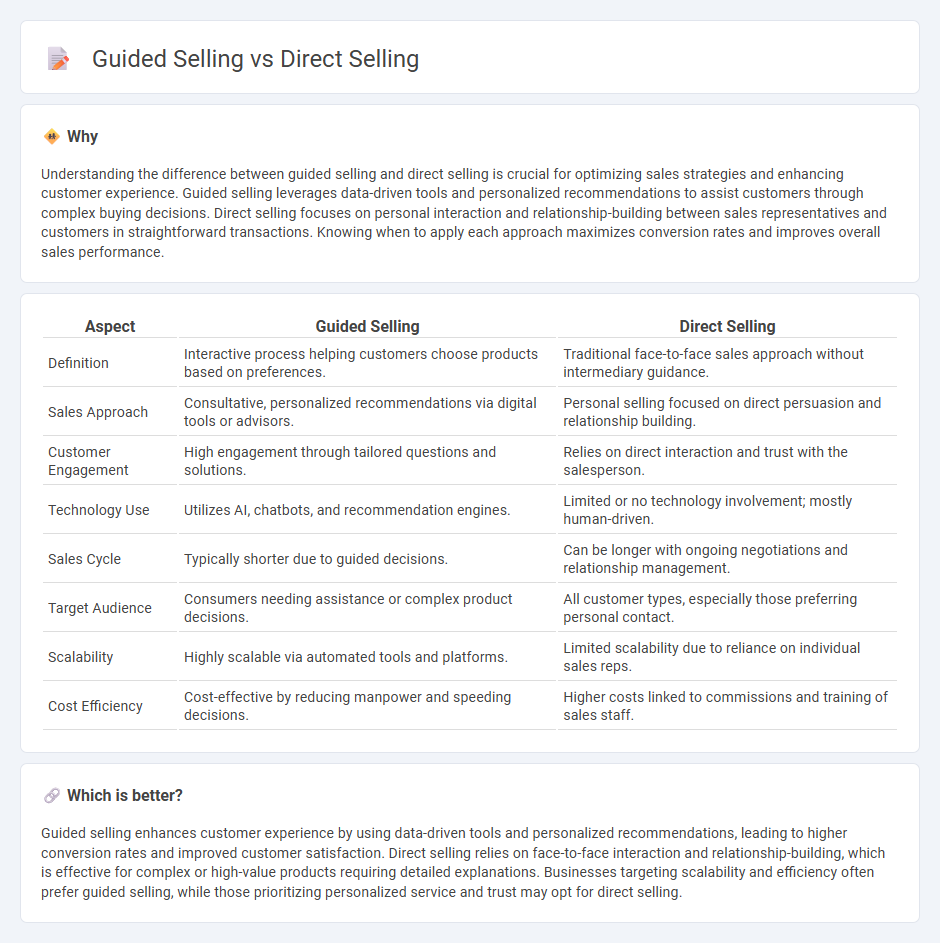
Guided selling leverages interactive tools and data analytics to assist customers in making informed purchase decisions tailored to their needs, enhancing the overall buying experience. Direct selling involves face-to-face or direct interaction between sales representatives and customers, focusing on personalized communication and relationship building. Explore the key differences and benefits of guided selling versus direct selling to optimize your sales strategy.
Why it is important
Understanding the difference between guided selling and direct selling is crucial for optimizing sales strategies and enhancing customer experience. Guided selling leverages data-driven tools and personalized recommendations to assist customers through complex buying decisions. Direct selling focuses on personal interaction and relationship-building between sales representatives and customers in straightforward transactions. Knowing when to apply each approach maximizes conversion rates and improves overall sales performance.
Comparison Table
| Aspect | Guided Selling | Direct Selling |
|---|---|---|
| Definition | Interactive process helping customers choose products based on preferences. | Traditional face-to-face sales approach without intermediary guidance. |
| Sales Approach | Consultative, personalized recommendations via digital tools or advisors. | Personal selling focused on direct persuasion and relationship building. |
| Customer Engagement | High engagement through tailored questions and solutions. | Relies on direct interaction and trust with the salesperson. |
| Technology Use | Utilizes AI, chatbots, and recommendation engines. | Limited or no technology involvement; mostly human-driven. |
| Sales Cycle | Typically shorter due to guided decisions. | Can be longer with ongoing negotiations and relationship management. |
| Target Audience | Consumers needing assistance or complex product decisions. | All customer types, especially those preferring personal contact. |
| Scalability | Highly scalable via automated tools and platforms. | Limited scalability due to reliance on individual sales reps. |
| Cost Efficiency | Cost-effective by reducing manpower and speeding decisions. | Higher costs linked to commissions and training of sales staff. |
Which is better?
Guided selling enhances customer experience by using data-driven tools and personalized recommendations, leading to higher conversion rates and improved customer satisfaction. Direct selling relies on face-to-face interaction and relationship-building, which is effective for complex or high-value products requiring detailed explanations. Businesses targeting scalability and efficiency often prefer guided selling, while those prioritizing personalized service and trust may opt for direct selling.
Connection
Guided selling enhances direct selling by using intelligent tools that tailor product recommendations to individual customer needs, improving conversion rates and customer satisfaction. This data-driven approach supports direct sales representatives in delivering personalized experiences, accelerating decision-making and increasing sales efficiency. Integrating guided selling techniques within direct selling frameworks leverages technology to optimize the sales funnel from lead generation to closing deals.
Key Terms
Personalization
Direct selling emphasizes a personalized experience through one-on-one interactions, allowing sellers to tailor product recommendations based on individual customer preferences and needs. Guided selling leverages technology such as AI-driven quizzes and interactive tools to customize product suggestions, enhancing the shopping journey by providing relevant options quickly and efficiently. Explore the benefits of both methods to determine which personalization approach best drives customer satisfaction and sales.
Autonomy
Direct selling empowers customers with full autonomy, allowing them to browse, select, and purchase products independently at their own pace. Guided selling enhances decision-making by providing personalized recommendations and interactive support, combining customer autonomy with expert advice to improve satisfaction and conversion rates. Explore our detailed analysis to understand how balancing autonomy and guidance can optimize your sales strategy.
Consultation
Direct selling emphasizes personalized consultations to build trust and tailor products directly to customer needs, leveraging face-to-face interactions for higher engagement. Guided selling uses digital tools and algorithms to assist customers in navigating complex product choices through interactive consultations, enhancing decision-making efficiency. Explore how integrating these consultation approaches can optimize customer experience and boost sales performance.
Source and External Links
Direct selling - Direct selling is a business model where individuals buy products from a parent company and sell them directly to customers, either through single-level or multi-level marketing, often via personal presentations or online, bypassing retail stores.
Direct Selling Association - Direct selling offers entrepreneurial opportunities to independent contractors who market products outside fixed retail locations through personal selling, in-home demonstrations, or online, earning compensation from their own and their network's sales.
Direct Selling Explained: A Comprehensive Guide - Direct selling involves selling products or services directly to consumers or businesses without intermediaries and includes models like B2B sales for complex solutions and D2C sales for brand control and customer experience.
 dowidth.com
dowidth.com